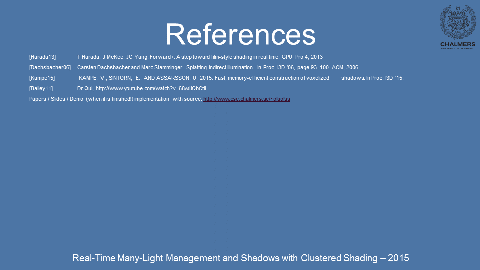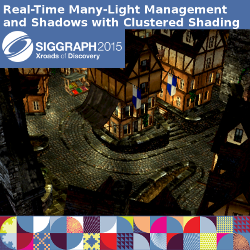
Real-Time Many-Light Management and Shadows with Clustered Shading
SIGGRAPH 2015 CourseOn this page:
Downloads
Grab the course slides of the SIGGRAPH 2015 course here (separate PDFs, one for each part):
- Part 1: Introduction To Real-Time Shading with Many Lights (Ola)
- Part 2: Practical Clustered Shading (Emil) (Emil)
- Part 3: Efficient Shadows from Many Lights (Ola)
- Part 4: Many-Light Rendering on Mobile Hardware (Markus)
The PDFs include both slides and notes. The trailer for Just Cause 3 that Emil ran during (or rather, after) his presentation can be found on youtube. Powerpoint files with embedded video and animations can be found on Ola’s page.
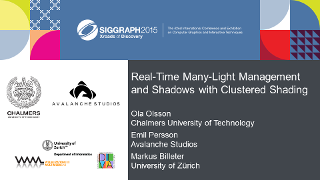
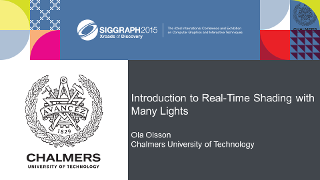
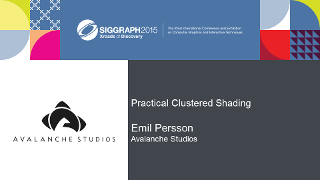
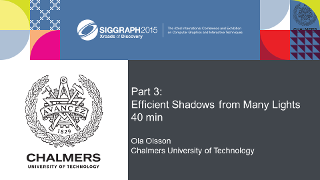
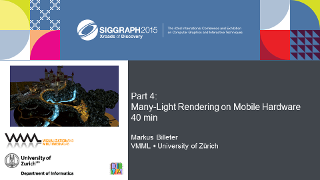
Abstract
Using many lights in real-time applications has been an important goal for many years. The games industry, in particular, has strived to increase the number of lights to provide enhanced visual quality and realism. Today, high-end games often make use of hundreds of lights in each frame, and the number of lights is likely to expand in the future. The ability to efficiently manage and shade large numbers of lights presents many possibilities, apart from simply allowing light to be cast from many dynamic objects. It can also support visualizing global illumination solutions, or enable detailed artistic light direction.
Efficient real-time shading with many lights helps solve several problems facing the development of next-generation high-end games. To achieve the level of performance needed to make this possible, light management and shading have evolved dramatically in recent years. Both industry and academia have invested significant effort in pursuit of this goal, which has resulted in a large number of new and sometimes competing techniques.
This course presents an in-depth exploration of many-light management, starting with background and progressing to state-of-the-art research, including recent results on supporting shadows. The course combines production experience from game developers with the latest research into efficient many-light algorithms for both desktop and mobile hardware.
References
Missing links = didn’t find a good online version.
Part 1: Introduction to Real-Time Shading with Many Lights
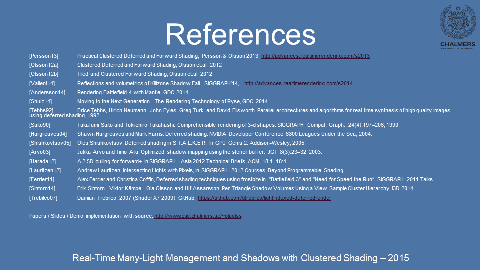
- Practical Clustered Deferred and Forward Shading; Persson & Olsson, 2013, Advances in Real-Time Rendering
- Clustered Deferred and Forward Shading; Olsson, Billeter & Assarsson, 2012. Paper
- Tiled and Clustered Forward Shading; Olsson, Billeter & Assarsson, 2012. Abstract
- Reflections and Volumetrics of Killzone Shadow Fall; Valient, 2014, Advances in Real-Time Rendering
- Rendering Battlefield 4 with Mantle; Andersson, 2014, GDC. Slides
- Moving to the Next Generation - The Rendering Technology of Ryse; Schulz, 2014, GDC. Slides
- Parallel architectures and algorithms for real-time synthesis of high quality images using deferred shading; Tebbs, Neumann, Eyles, Turk & Ellsworth, 1992. Tech Report
- Comprehensible rendering of 3-d shapes, Saito & Takahashi, 1990. Paper
- Deferred Shading; Hargreaves & Harris, 2004, NVIDIA Developer Conference: 6800 Leagues under the Sea. Slides
- Deferred shading in S.T.A.L.K.E.R.; Shishkovtsov, 2005, GPU Gems 2. Article
- Optimized shadow mapping using the stencil buffer; Arvo & Aila, 2003, JGGGT
- A 2.5D Culling for Forward+; Harada, 2012, SIGGRAPH Asia Technical Briefs. Slides, ACM
- Intersecting Lights with Pixels; Lauritzen, 2012, Beyond Programmable Shading - SIGGRAPH Courses. Slides
- Deferred shading techniques using Frostbite in Battlefield 3 and Need for Speed: The Run; Ferrier & Coffin, 2011, SIGGRAPH Talks. ACM
- Per-Triangle Shadow Volumes using a View-Sample Cluster Hierarchy; Sintorn, Kämpe, Olsson & Assarsson, 2014, I3D. Paper
- Light Indexed Deferred Lighting; Treblico, 2007. Link
Part 2: Practical Clustered Shading
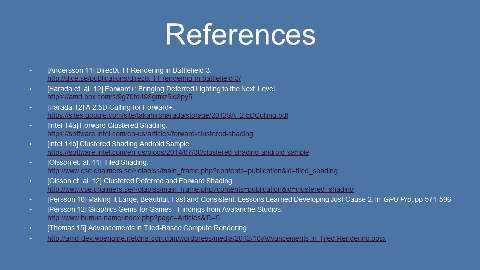
- DirectX 11 Rendering in Battlefield 3; Andersson, 2011. Slides
- Forward+: Bringing Deferred Lighting to the Next Level; Harada, McKee & Yang, 2012.
- A 2.5D Culling for Forward+; Harada, 2012. Paper
- Forward Clustered Shading; Svilpa, 2014. @ Intel
- Clustered Shading Android Sample; Yusov, 2014. @ Intel
- Tiled Shading; Olsson & Assarsson, 2011. Paper
- Clustered Deferred and Forward Shading; Olsson, Billeter & Assarsson, 2012. Paper
- Making It Large, Beautiful, Fast and Consistent: Lessons Learned Developing Just Cause 2; Persson, 2010. In GPU Pro
- Graphics Gems for Games - Findings from Avalanche Studios; Persson, 2012. Link
- Advancements in Tile-Based Compute Rendering; Thomas 2015. Slides
Part 3: Efficient Shadows from Many Lights
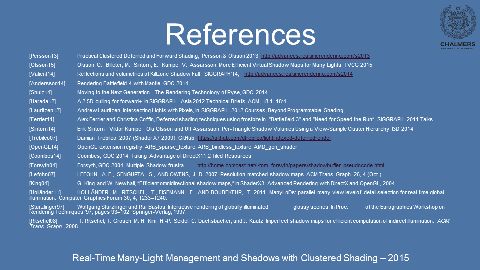
- Practical Clustered Deferred and Forward Shading; Persson & Olsson, 2013, Advances in Real-Time Rendering
- More Efficient Virtual Shdaow Maps for Many Lights; Olsson, Billeter, Sintorn, Kämpe & Assarsson, 2015, TVCG. Paper
- Reflections and Volumetrics of Killzone Shadow Fall; Valient, 2014, Advances in Real-Time Rendering
- Rendering Battlefield 4 with Mantle; Andersson, 2014, GDC. Slides
- Moving to the Next Generation - The Rendering Technology of Ryse; Schulz, 2014, GDC. Slides
- A 2.5D Culling for Forward+; Harada, 2012, SIGGRAPH Asia Technical Briefs. Slides, ACM
- Intersecting Lights with Pixels; Lauritzen, 2012, Beyond Programmable Shading - SIGGRAPH Courses. Slides
- Deferred shading techniques using Frostbite in Battlefield 3 and Need for Speed: The Run; Ferrier & Coffin, 2011, SIGGRAPH Talks. ACM
- Per-Triangle Shadow Volumes using a View-Sample Cluster Hierarchy; Sintorn, Kämpe, Olsson & Assarsson, 2014, I3D. Paper
- Light Indexed Deferred Lighting; Treblico, 2007. Link
- OpenGL Extensions:
ARB_sparse_texture,ARB_bindless_texture,AMD_gcn_shader - Taking Advantage of DirectX11.2 Tiled Resources; Coombes, 2014, GDC Link
- Multiple Shadow Frustra; Forsyth, 2004, GDC. Link
- Resolution-matched shadow maps; Lefohn, Sengupta & Owens, 2007. Paper
- Efficient omnidirectional shadow maps; King & Newhall, 2005. In ShaderX3
- ManyLoDs: Parallel Many-View Level-of-detail selection for real-time global illumination; Holländer, Ritschel, Eisemann & Boubekeur, 2011. Paper
- Interactive rendering of globally illuminated glossy scenes; Stürzlinger & Bastos, 1997, Eurographics Workshop on Rendering Techniques. Paper (.ps.gz!)
- Imperfect Shadow Maps for Efficient Computation of Indirect Illumination; Ritschel, Grosch, Kim, Seidel, Dachsbacher & Kautz, 2008. Paper
- Forward+: Bringing deferred lighting to the next level; Harada, McKee & Yang, 2012. Slides
- Splatting indirect illumination; Dachsbacher & Stamminger, 2006, I3D. Paper
- Fast, memory-efficient constructionof voxelized shadows; Kämpe, Sintorn & Assarsson, 2015, I3D. Paper
- Dr. Qui; Bailey, 2008, The Royal Albert Hall. Youtube
Part 4: Many-Light Rendering on Mobile Hardware
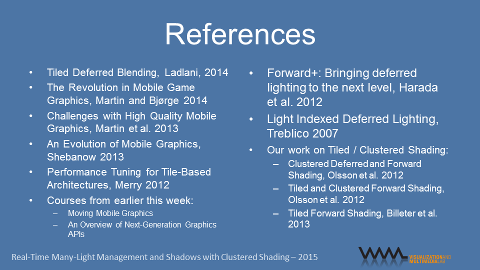
- Moving Mobile Graphics, SIGGRAPH 2015 course. Course Material
- An Overview of Next-Generation Graphics APIs, SIGGRAPH 2015 course. Course Material
- Tiled deferred blending; Ladlani, 2014. In GPU Pro 5
- The Revolution in Mobile Game Graphics; Martin & Bjørge, 2014. Slides
- Challenges with High Quality Mobile Graphics; Martin, Bjørge, Kakarlapudi & Fredriksen, 2013. Slides
- An Evolution of Mobile Graphics; Shebanow, 2013. Slides
- Performance Tuning for Tile-Based Architectures; Merry, 2012. Article
- Forward+: Bringing deferred lighting to the next level; Harada, McKee & Yang, 2012. Slides
- Light Indexed Deferred Lighting; Treblico, 2007. Link
- Tiled Forward Shading; Billeter, Olsson & Assarsson, 2013. In GPU Pro 4
- Clustered Deferred and Forward Shading; Olsson, Billeter & Assarsson, 2012. Paper
- Tiled and Clustered Forward Shading; Olsson, Billeter & Assarsson, 2012. Abstract
Links
Find the slides that we original submitted when the course was accepted in the ACM Digital Library. The slides available on this page are more up-to-date, however.
Co-authors
Errata
(Find anything inaccurate, any errors? Something worth pointing out? Send me an email!)
